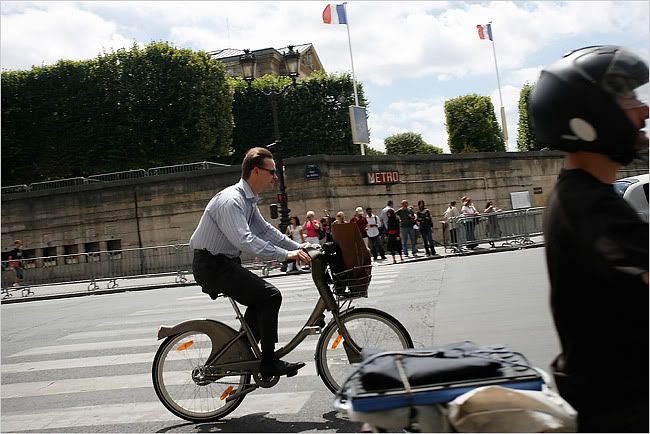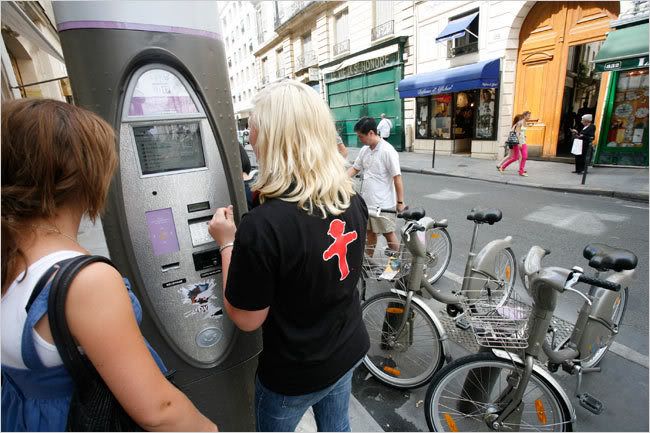W. K. Lis
Superstar
NYC closing 2 lanes on Broadway for pedistrians and bicycles
Closing on Broadway: Two Traffic Lanes
From a New York Times article:
Closing on Broadway: Two Traffic Lanes
From a New York Times article:
In a surprising reshaping of the urban landscape, the city is creating a public esplanade along a portion of one of its most prominent streets, Broadway in Midtown, setting aside the east side of the roadway for a bicycle lane and a pedestrian walkway with cafe tables, chairs, umbrellas and flower-filled planters.
The esplanade, which the city is calling Broadway Boulevard, will run from 42nd Street to Herald Square. Scheduled to open in mid-August, it will change that section of Broadway from a four-lane to a two-lane street.
“I’m envisioning it as a public park on the street,†said Barbara Randall, the executive director of the Fashion Center Business Improvement District, which is working with the city’s Department of Transportation to create the boulevard.
The work, which has begun without a formal public announcement, reflects Mayor Michael R. Bloomberg’s sweeping vision of reducing pollution and traffic congestion in New York, and particularly Manhattan, by increasing open space and encouraging bike riding and other alternatives to cars.
The plan also makes clear that the Bloomberg administration, after losing its bid in Albany for a congestion-pricing plan that would have fought traffic by charging drivers to enter the area of Manhattan below 59th Street, intends to push ahead with smaller-scale initiatives to wrest at least part of the street from cars and trucks.
Other recent initiatives from the Transportation Department include banning cars on Park Avenue on three Saturdays in August and exploring a bicycle-sharing program.
The new esplanade “will transform all of Broadway, visually and mentally†Ms. Randall said. “People will start thinking of the street differently. They’ll start thinking of it as a destination where you can watch the world go by.â€
Transportation Commissioner Janette Sadik-Khan said that the esplanade, which was designed with the help of Jan Gehl, a well-known urban designer based in Copenhagen who has been hired as a consultant by the city, was part of a larger program to turn underused street space into public plazas in each of the city’s 59 community board districts.
But Ms. Sadik-Khan acknowledged that there was a special significance when the street was one of the city’s most famous thoroughfares.
“Broadway is not famous because there are a gazillion cars going through it,†she said. “We’re trying to have the public space match the name.â€
“It’s a really important signal of how we can transform the streets of New York,†she added.
There are questions, however, about the impact the narrower Broadway will have on Midtown traffic. (Ms. Sadik-Khan said that a two-lane Broadway would be able to handle the traffic flow just fine.) Some workers in the area wondered whether people would flock to dine and relax so close to a busy route’s speeding taxis, noisy trucks and exhaust fumes.
“They’ll have carbon monoxide in their tuna fish,†said Corey Baker, 31, who works at a fashion branding company at Broadway and 41st Street.
Still, Mr. Baker said that the neighborhood would benefit from more open space and added that he might even use it.
“If it was a tourist crowd, then no,†Mr. Baker said. “If it was other people grabbing lunch, then it’s good.â€
Many people interviewed on Broadway on Thursday were curious about the work, which included newly painted pavement and orange-and-white plastic traffic barriers that had mysteriously appeared on the street in recent days.
Ms. Sadik-Khan said that the department was planning to unveil the project closer to its scheduled completion, on Aug. 15. But she said that officials had spent months discussing it with the three business improvement districts and the local community board.
She said the city was spending $700,000 to create the string of blocklong plazas from 42nd to 35th Streets. That includes painting the bike lane green, buying the chairs, tables, benches, umbrellas and planters and applying a coat of small-grained gravel mixed with epoxy onto the pedestrian areas, which will set them off from both the street and the bicycle path.
The three business improvement districts — the Times Square Alliance, the Fashion Center B.I.D. and the 34th Street Partnership — have agreed to pay for maintenance, which primarily involves buying and maintaining the plants for the planters. They estimate the cost at about $280,000 a year.
The planters are a key part of the design because they will be the only thing separating the expanded pedestrian areas from the cars and trucks zipping by.
Nevertheless, many people on Broadway on Thursday said they would welcome the new plazas in an area that has a shortage of places to sit outdoors. About the only such place along that stretch of Broadway is Golda Meir Square, a small plaza in front of 1411 Broadway, at 39th Street, where folding chairs are set out during the day.
On Thursday, there were a couple of dozen chairs, all occupied. Those who could not get a chair sat among the pigeons on the steps leading to a platform with a bust of Golda Meir.
Andre Fisher, 54, a clothing manufacturer who works in the garment district, was soaking up the sun in one of the chairs. “I think we’ve got enough places for cars and not enough places for people to sit,†he said, endorsing the idea.
Several people wondered about the impact on traffic, but Ms. Sadik-Khan said that it would be slight. In its current configuration, Broadway has two lanes for traffic north of Times Square, widens to four lanes from 42nd Street to Herald Square, and then returns to two lanes.
Ms. Sadik-Khan said that the heaviest downtown traffic in the area was on the avenues, not on Broadway. And she said that drivers would learn to adapt.
“It’s going to be clear if you really want to go downtown and you’re in a car you’re going to be much better off going down one of the avenues than going down Broadway,†she said.
The city has already carved out smaller plazas in several neighborhoods. One is at the corner of 14th Street and Eighth Avenue in Manhattan and another on a block of Willoughby Street in Brooklyn, where it intersects with Fulton Street. The city is also working to create more boulevard-like space along a shorter section of Broadway near Madison Square Park.
On Willoughby Street, Shakir Thompson, 44, sat on a chair on Thursday studying a textbook on electrical theory. He said he used the plaza daily.
“It’s nice, it’s calm,†he said, despite th buzz of nearby traffic. “In the country they wouldn’t relate to this. But in the city we have to take what we can get.â€







